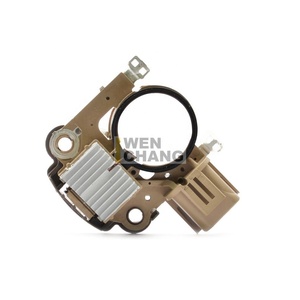(1076 products available)
















































































































Alternators are devices that generate electricity. In a Canter, the alternator creates power to recharge the battery and supply electricity to the vehicle’s electrical system when driving. There are different types of Canter alternators, including:
Canter AFB Alternator:
This is the Mitsubishi Canter alternator. It is a powerful, compact, and lightweight alternator that is ideal for a wide range of applications, including trucks and commercial vehicles.
Key features of the AFB alternator include:
1. The use of an advanced rotor design that improves ventilation, resulting in better cooling and improved performance.
2. Its lightweight and compact design, which makes it ideal for applications where weight and space are critical.
3. AFB alternators have a low-noise design, making them ideal for applications where noise should be minimized.
Canter 4D Alternator:
This is the alternator for the Mitsubishi 4D Canter engine. The alternator for the 4D engine is specifically designed to meet the electrical requirements of the 4D engine.
The key features of the alternator for the 4D engine include:
1. It has a higher electrical output compared to the AFB alternator. The alternator for the 4D engine has a higher output voltage and current, making it suitable for powering additional electrical components like GPS, digital dashboards, and other modern electrical accessories.
2. This alternator is designed to generate less noise and is more efficient than the AFB alternator.
3. The alternator for the 4D engine has a wider operating temperature range. This is important because the 4D engine generates more heat than the AFB alternator.
Canter Fuso Alternator:
The Fuso Canter alternator is designed for the Mitsubishi Fuso Canter. The Fuso Canter alternator is designed to meet the electrical requirements of the Fuso Canter’s diesel engine. This alternator is ideal for heavy-duty applications.
Key features of the Fuso Canter alternator include:
1. The alternator for the Fuso Canter is designed to be durable and reliable, making it suitable for long-haul applications.
2. It is designed with a more efficient cooling system. The cooling system of the Fuso Canter alternator is designed with a more efficient cooling system to withstand high ambient temperatures.
3. This alternator has a more advanced voltage regulator. The voltage regulator of the Fuso Canter alternator is designed to be more advanced and can maintain a more stable voltage output, ensuring the electrical system functions optimally even under heavy load.
Check out the specifications of Canter alternators in the following:
Rated Current
Canter alternators have a rated current of 70-150 A. This is the maximum current that the alternator can continuously supply at its rated voltage.
Rated Voltage
The alternator has a rated voltage of 12-24 V. This is the voltage of the electrical system that the alternator is designed to work with.
Frequency
The frequency of Canter alternators is 50-60 Hz, which is the frequency of the electrical system that the alternator is designed to work with.
Cooling Method
Cantor alternators are externally cooled. This means that the alternator is cooled by air flowing over it from the outside.
Insulation Class
The insulation class of Canter alternators is F-H. This means that the alternator is designed to operate at high temperatures (up to 155°C) and can withstand harsh environmental conditions.
Dimensions
The size of Canter alternators varies depending on the model, but they are typically between 300-400 mm in length, 200-300 mm in width, and 150-200 mm in height.
Weight
The weight of Canter alternators also varies depending on the model, but they are typically between 5-10 kg.
Here are a few tips for maintaining the Mitsubishi Canter alternator:
By following these maintenance tips, the Canter alternator can work well and last longer.
There are several factors to consider when choosing the right Canter alternator for a specific vehicle or application.
Many alternator replacement steps are provided by the manufacturer for specific vehicle models. Generally, replacing an alternator can be a straightforward DIY task for those with mechanical experience. Before starting the replacement process, it's important to read the service manual and gather all the necessary tools. Below are the general steps for replacing alternators:
Preparation
Ensure that the engine is cool before opening the hood. Wear safety glasses and gloves during the process. Disconnect the negative battery cable to avoid accidents and electrical short circuits. Locate the alternator by referring to the service manual. Remove any covers or components that may obstruct accessing the alternator.
Removing the Old Canter Alternator
It's important to note the alternator belt routing before removing it. Loosen the tensioner pulley or any other component holding the belt in place and remove the belt from the alternator. Disconnect the electrical connections from the alternator. Remove the mounting bolts holding the alternator in place. The number of bolts might vary depending on the engine model. Once the bolts are removed, the alternator can be wobbled and pulled out of its bracket.
Installing the New Canter Alternator
Slide the new alternator into its bracket and secure it with the mounting bolts. Reconnect the electrical connections to the new alternator, ensuring they are tight and secure. Route the alternator belt according to the previously noted pattern and adjust the tensioner pulley or other components to keep the correct belt tension. Reconnect the negative battery cable to ensure the electrical system works. Start the engine and observe the new alternator to ensure no strange noises or vibrations.
Q1: What is the warranty period for Canter alternators?
A1: The duration of the warranty period can vary depending on the manufacturer or supplier's terms. Generally, the warranty period can range from 6 months to 1 year. Users should read the warranty terms to know the alternator's coverage and conditions.
Q2: How do you know when to replace the alternator?
A2: If users notice signs like frequent battery drainage, dimming lights, or strange noises from the alternator, it may be time to replace it. Additionally, if the alternator shows any physical damage or wear, a replacement may be necessary.
Q3: Can a damaged alternator be repaired, or is replacement always necessary?
A3: In some cases, alternator parts like bearings or the regulator may be repaired. However, repairs are rarely recommended because repairs can be less reliable than replacements. Therefore, if the alternator has a small, inconsistent repair, users should replace it with a new, reliable alternator.
Q4: Can any alternator be used for a Canter vehicle, or should it be specific to the model?
A4: Not all alternators are suitable for Canter vehicles. Each vehicle model needs a specific alternator according to the engine size and other electrical components. Using a non-specific alternator can cause compatibility issues and affect performance.
Q5: How long does it take to replace a Canter alternator?
A5: The alternator replacement time can vary depending on the mechanic's expertise and the alternator's location on the vehicle. Usually, the replacement time can range from 1 to 3 hours.